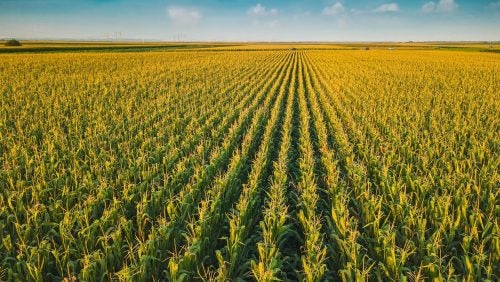Commodities v. Climate: How the Ongoing Battle Over the Farm Bill Reflects the Tension Between Modern Food Production and Effective Climate Response
March 21, 2024 by Damon Hays

The current impasse over the nation's premier agriculture legislation is one that reflects the competing interests of modern food production practices and climate change mitigation efforts.
In December 2022, I wrote with skepticism about the prospect of Congress passing a 2023 Farm Bill which could take effective steps toward addressing agricultural production’s contributions to climate change.1 Fifteen months later Congress remains at an impasse over climate funding which threatens to prohibit the passage of the Farm Bill in any form, much less one which tackles the climate crisis.2 The failure to agree on a solution comes despite eclipsing the initial September, 2023 expiration of the 2018 Farm Bill.3 As a result, Congress passed a one-year extension of the previous Act, resetting the deadline to September 30, 2024.4
The current spat preventing any movement on the Farm Bill comes down to partisan disagreement over the use of the Inflation Reduction Act’s (IRA) agriculture-related climate conservation spending.5 Starting from its passage in 2022, the IRA provided $19.5 billion in funding to farm bill conservation programs through 2031.6 Republican lawmakers are calling for re-allocation of this funding for climate-smart agriculture and forestry activities to all forms of agricultural conservation, regardless of its relation to the climate crisis.7 In addition to this reallocation, Congressional conservatives have proposed the funding guaranteed by the IRA be distributed over 25 years, rather than the established 8.8
Some Republican lawmakers would go even further in diverting IRA spending from its initial climate conservation focus. Chair of the House Committee on Agriculture Glenn “G.T.” Thompson has proposed re-allocating the IRA climate funds not only to non-climate related conservation programs, but also to farm programs with no substantial relation to environmental objectives whatsoever, including protections for commodity production.9
The Republican attempt to reallocate IRA spending has been framed as primarily an attempt to dismantle a central and popular Democratic achievement.10 While partisan logic dictates that this framing is almost certainly true, the structure that the dismantling attempt has taken is instructive in identifying the inherent incompatibility of preserving current food production practices and addressing issues of climate change.
In making this analogy to the difficulty in cultivating climate solutions in the face of modern agricultural practices, the Republican call for re-allocation of funds represents the continuation of the industrial agriculture status quo. The re-allocation plan preserves this status quo in two primary ways. First, by attempting to distribute the IRA funds to programs unrelated to climate conservation, GOP lawmakers are conserving the existing practices of food production which have contributed to the climate crisis. Second, by extending the timescale of the funding, the re-allocation plan seeks to perpetuate those practices over a timescale of at least 25 years.
The status quo which this effort to undermine the IRA’s climate-smart agriculture initiatives seeks to preserve is one which has contributed significantly to the climate crisis. Agricultural production contributes 11% of domestic greenhouse gas emissions.11 Of particular concern is agriculture’s status as the primary source of nitrous oxide (N2O) and methane (CH4).12 These gases contribute more strongly to the greenhouse effect than carbon dioxide (CO2) and are thus assigned substantially higher values of Global Warming Potential.13 The vast majority of these emissions both domestically and worldwide come from the production of commodity crops.14
A 2019 IPCC report on the pathways to 1.5 degrees Celsius warming limit provided estimates on the emissions reductions necessary within the agriculture, forestry, and land use sector to meet the 1.5 degree limit.15 The report stated that CO2 emissions in the sector must be net negative by 2030.16 Additionally, N2O emissions from agriculture, forestry, and land use must be reduced by 10-15% and CH4 emissions require a 25-35% reduction by 2030 to meet the proposed warming cap.17 While the IRA’s climate-smart funding is not alone sufficient to create the reductions necessary to bring the U.S. into compliance with these urgent goals, it at least recognized the need for immediate and targeted action on climate change. The Republican re-allocation plan, on the other hand, provides no such hope for transitioning toward methods of production which may reduce our food production emissions. If Congressman Thompson has his way, the IRA’s initial effort to work to climate solutions in agriculture will be repurposed to ensure the continuation of the practices that have been the worst emissions offenders. This tension between Democratic recognition of the need to change and Republican insistence of perpetuating the status quo is thus a microcosm of the wider battle between the climate and the existing methods of industrial agriculture.
1 Damon Hays, Can the Farm Bill Address Climate Change, GEO. ENV’L L. REV. BLOG (Dec. 22, 2022), https://www.law.georgetown.edu/environmental-law-review/blog/can-the-farm-bill-address-climate-change /.
2 Megan Bland, Conservation Issues Are Central to the Ongoing Farm Bill Debate, NAT’L CONF. OF STATE LEGISLATURES (Mar. 18, 2024), https://www.ncsl.org/state-legislatures-news/details/conservation-issues-are-central-to-the-ongoing-farm-b ill-debate.
3 Leah Douglas, US government spending bill extends farm programs, some nutrition aid, REUTERS (Nov. 17, 2023), https://www.reuters.com/world/us/us-government-spending-bill-extends-farm-programs-some-nutrition-aid -2023-11-17/.
4 Id.
5 Marc Heller, Republicans turn up pressure on farm bill ‘conservation cliff’, E&E DAILY (Mar. 14, 2024), https://subscriber.politicopro.com/article/eenews/2024/03/14/republicans-turn-up-pressure-on-farm-bill-co nservation-cliff-00146829.
6 Jonathan Coppess et al., Reviewing the Inflation Reduction Act of 2022; Part 1, FARMDOCDAILY (Aug. 11, 2022), https://farmdocdaily.illinois.edu/2022/08/reviewing-the-inflation-reduction-act-of-2022-part-1.html.
7 Avoiding The Conservation Cliff – A Bipartisan Solution, U.S. SENATE COMM. ON AGRIC., NUTRITION, & FORESTRY: MINORITY BLOG (Mar. 13, 2024), https://www.agriculture.senate.gov/newsroom/minority-blog/avoiding-the-conservation-cliff_a-bipartisan-s olution.
8 Id.
9 Marc Heller, Thompson stands by plan to ‘repurpose’ climate law funds, E&E DAILY (Dec. 7, 2023), https://subscriber.politicopro.com/article/eenews/2023/12/07/thompson-stands-by-plan-to-repurpose-clima te-law-funds-00130374.
10 Jael Holzman, Inside the IRA farm fight, AXIOS PRO (Mar. 15, 2023), https://www.axios.com/pro/energy-policy/2023/03/15/inside-the-ira-farm-fight.
11 https://www.epa.gov/ghgemissions/sources-greenhouse-gas-emissions.
12 Id.
13 EPA, Sources of Greenhouse Gas Emissions, https://www.epa.gov/ghgemissions/understanding-global-warming-potentials.
14 See generally David Laborde et al., Agricultural subsidies and global greenhouse gas emissions, 12 Nature Commc’n 2601 (2021).
15 JOERI ROGELJ ET AL., MITIGATION PATHWAYS COMPATIBLE WITH 1.5OC IN THE CONTEXT OF SUSTAINABLE DEVELOPMENT 115–19 (IPCC 2018).
16 Id.
17 Id.

